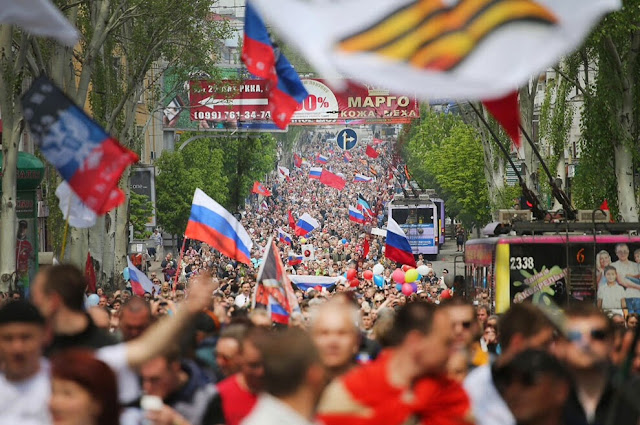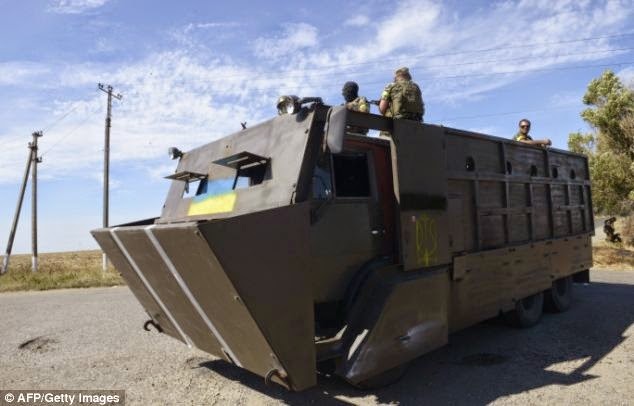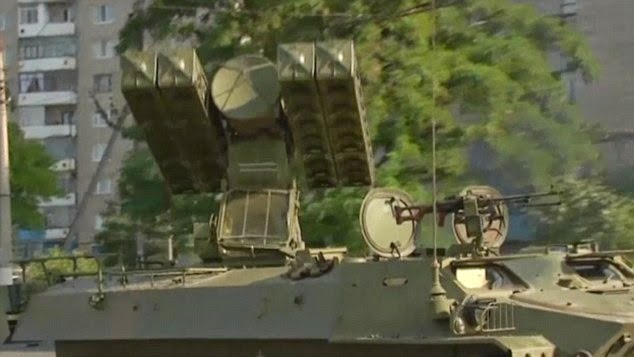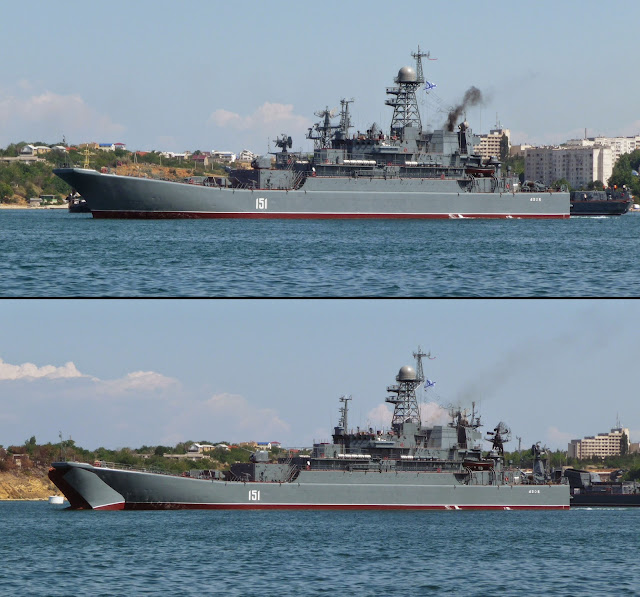Pro-Russian activists march on May 1, 2014 in Donetsk, Ukraine. Following the rally, activists marched through the city and clashed with police during a takeover of the city prosecutors office. The activists confiscated riot gear from the defeated police force guarding the building. (Scott Olson/Getty Images)
"Frank Kitson's book will be of special interest to those of us who served in Kenya during the Mau Mau rebellion since few people could be told at the time of the special operations developed by him. But there are many lessons in his story which will be of equal interest to those whose business it is to study or take part in the restoration of law and order. The British Army has been kept busy with that kind of work in recent years.
Global war is an international affair and it is in the international field that our statesmen will strive to reach agreement to reduce the likelihood of such a calamity. But keeping control in our Colonies and Protectorates is our own affair. The likelihood of military support to our Colonial administration must be rated high.
In Africa alone there are vast areas which under our guidance are moving towards a greater degree of self government. We are deliberately moving the responsibility more and more on to the shoulders of the local inhabitants. This involves risks to law and order which must be accepted if these people are to move from the benevolent autocracy of good Colonial administration to independence, with all the dangers, disturbances and upheavals which such a change entails.
If this change is to be made smoothly, with firm foundations laid for the future, the timing must be controlled. The Colonial administration must not be stampeded into making the change because its administration has become so weak it cannot resist. It would be the worst possible service to the people of Africa to give independence against a background of confusion.
If the Army is required to intervene it should try to do so in such a way that it does not prejudice the natural progressive development of the territory. No lasting results will be obtained by the unintelligent use of force in all directions. Measures must be designed to support and protect the loyal members of the community and to round up the real trouble-makers who have resorted to force and lawlessness. If this can be done fairly and justly you will get the support of the waverers and the battle is half won. But to do this you must have a very good intelligence service. You must not be surprised to find that it is inadequate and your first task should be to build up."
General Sir George Erskine G.C.B, K.B.E, D.S.O
Press releases
7 September 2014
Ukraine: Mounting evidence of war crimes and Russian involvement
Ukrainian militia and separatist forces are responsible for war crimes, Amnesty International said today. The organisation accused Russia of fuelling separatist crimes as it revealed satellite images indicating a build-up of Russian armour and artillery in eastern Ukraine.
With cease-fire talks still uncertain and the situation on the ground perilous, Amnesty International calls on all parties, including Russia, to stop violations of the laws of war.
“All sides in this conflict have shown disregard for civilian lives and are blatantly violating their international obligations,” said Salil Shetty, Amnesty International’s Secretary General, who travels to Kyiv and Moscow in the coming days.
“Our evidence shows that Russia is fuelling the conflict, both through direct interference and by supporting the separatists in the East. Russia must stop the steady flow of weapons and other support to an insurgent force heavily implicated in gross human rights violations.”
Amnesty International researchers on the ground in eastern Ukraine have documented incidents of indiscriminate shelling, abductions, torture, and killings.
The Kremlin has repeatedly denied any involvement in the fighting in Ukraine, but satellite imagery and testimony gathered by the organization provide compelling evidence that the fighting has burgeoned into what Amnesty International now considers an international armed conflict.
The images show new artillery positions being established just inside the Ukrainian border between 13 and 29 August, including what appear to be 122-mm Howitzer D-30 artillery units in firing positions pointed toward the west. Two of the positions have a support vehicle and what looks like bunkers.
On 29 August, six armoured amphibious vehicles (likely BRDM-2s) can be seen.
Bulgarian rides off the ramp from USNS Red Cloud (T-AKR 313) at Souda Bay, Greece, en route to Bulgaria, after returning from deployment in Iraq. 26 May 2005.
Souda Bay, Crete, Greece - The Military Sealift Command (MSC) large, medium-speed, roll-on/roll-off ship USNS Red Cloud (T-AKR 313), off-loads coalition combat equipment and supplies at Souda Bay, Greece, after returning from deployment in Iraq.
The Bulgarian BRDM-2 wheeled and tracked vehicles are being returned to Bulgaria by the MSC after completing a tour of duty in support of Operation Iraqi Freedom (OIF).
Another similar artillery position can be seen in a field northeast of the first, also within Ukrainian territory. Imagery from 26 August 2014 shows six relatively advanced self-propelled howitzers (likely 2S19 Msta-S 152-mm) in firing positions facing southwest at Ukrainian army locations.
Ukrainian 2S19 Msta-S self-propelled howitzer during the Independence Day parade in Kiev, Ukraine in 2008.
Between 26 and 29 August 2014 the artillery has been moved into a west facing firing position still within Ukraine. On August 29 the imagery shows what look like numerous military vehicles in the area along the tree line and in the neighboring field.
“These satellite images, coupled with reports of Russian troops captured inside Ukraine and eyewitness accounts of Russian troops and military vehicles rolling across the border leave no doubt that this is now an international armed conflict,” said Shetty.
Amnesty International researchers on the ground in eastern Ukraine interviewed eyewitnesses fleeing from fighting near Alechevsk, Donetsk, Kramatorsk, Krasny Luch, Lisichansk, Lugansk, Rubeznoe, Pervomaisk and Slovyansk. Researchers also interviewed Ukrainian refugees in the Rostov region of Russia.
Civilians from these areas told Amnesty International that the Ukrainian government forces subjected their neighbourhoods to heavy shelling. Their testimonies suggest that the attacks were indiscriminate and may amount to war crimes. Witnesses also said that separatist fighters abducted, tortured, and killed their neighbours.
In an illustrative incident, residents of Slovyansk told Amnesty International that separatist fighters kidnapped a local pastor, two of his sons and two churchgoers, and requested a US$50,000 ransom for their release. By the time the local community managed to collect the requested ransom, the witnesses said, the captors had killed all of the men.
Amnesty International has also received credible reports of abductions and beatings carried out by volunteer battalions operating alongside regular Ukrainian armed forces.
For example, on 23 August a security guard in Oleksandrivka, Luhansk region was seized by several dozen armed men who arrived in vehicles flying Ukrainian flags. At least one was marked “Battalion Aidar” (a militia group operating in the Luhansk region). Witnesses said his captors accused him of collaborating with separatists, beat him with rifle butts and held him incommunicado until 27 August, when his family were informed he was being held in another town, in the local office of Ukraine’s state security service.
Amnesty International is calling on the Ukrainian authorities to conduct an effective investigation into allegations of serious violations of international humanitarian law and bring to justice individuals responsible for war crimes. Commanders and civilian leaders may also be prosecuted for war crimes as a matter of command responsibility if they knew or should have known about the crimes and failed to prevent them or punish those responsible.
“Civilians in Ukraine deserve protection and justice,” Salil Shetty said.
“Without a thorough and independent investigation, there’s a real risk Ukrainians will harbour the scars of this war for generations.”
To download Amnesty International’s embargoed satellite images, click here:
http://tinyurl.com/Amnesty-Ukraine-Images
Salil Shetty and an Amnesty International delegation will be in Kyiv from 7-8 September, and in Moscow from 9-10 September.
For more information, or to arrange an interview, please contact:
In Kyiv: Bogdan Ovcharuk, Media and Communications Officer, Amnesty International Ukraine, Tel: +38 044 483 26 06, Mobile: +38 067 551 69 44, Email: b.ovcharuk@amnesty.org.ua
In London: Lydia Aroyo, Europe and Central Asia Press Officer, International Secretariat, Tel: +44 20 7413 5599, Email: Lydia.Aroyo@amnesty.org, Out of hours Press Mobile (7pm GMT – 9am GMT and weekends) +44 (0) 777 847 2126
Region Europe And Central Asia
Country Ukraine
Media Centre
Ukraine alleged on Wedensday that a huge convoy of up to 100 Russian tanks, armoured vehicles and rocket launchers had infiltrated its territory
There was a second report of a border crossing by five armoured infantry carriers and one Kamaz truck at Amvrosiyivka, said security spokesman Andriy Lysenko.
Ukrainian premier Arseny Yatseniuk said his country needed 'practical help' from Nato, with which it has the status of a special partner, and demanded 'momentous' decisions at its summit in Wales in early September.
He also claimed Russia was set to turn off the gas supply taps to Europe this winters.
Nato chief Anders Fogh Rasmussen vowed to create a new 'spearhead' force with 'very, very high readiness' to cope with what the alliance saw as Russia's new belligerence.
It came as the strategically important town of Novoazovsk, in the south-east of the country, was shelled by pro-Russian forces today.
The attack raised fears of a counter-offensive by Ukrainian forces.
In response to outgoing fire early this morning, pro-Moscow forces lobbed at least 10 shells at the Kiev stronghold, with plumes of black smoke rising above the town.
Mr Putin alleged the detention of 10 Russian servicemen came after they crossed the border 'by accident', a claim widely disbelieved in Kiev, which claims it has faced repeated attacks from Kremlin troops in a conflict which has seen almost 2,300 deaths.
A nurse holds a weapon as she helps a wounded pro-Russian gunman to exit a car in front of a hospital in Slovyansk, eastern Ukraine, on May 5, 2014. Ukrainian troops fought pitched gun battles Monday with a pro-Russia militia occupying the eastern city -- an apparent escalation of their efforts to bring the region back under government control. (AP Photo/Darko Vojinovic)
Figure 9. Closer view of probable 2S19 Msta-S Howitzers. One of a series of satellite images commissioned by Amnesty International to illustrate troop and opposition movements in Eastern Ukraine.
[Methods: An area of approximately 100 square kilometers was analyzed for military activity in the Starobeshevo region, eastern Ukraine near the border with Russia, between 13 August 2014 and 29 August 2014. Two areas showed evidence of increased strategic military activity over the timeframe, with large increases in military vehicles and advanced artillery inside Ukraine. Because of sporadic cloud cover in imagery from 29 August 2014 the first area could not be analyzed on that date.
Key Findings: New artillery positions can be seen inside the Ukrainian border, including probable 122-mm Howitzer D-30 artillery, in a firing position pointed toward the west in the direction of Ukraine's armed forces. Two of the D-30 positions observed have one support vehicle each, and a probable bunker.
In the period between 26 August and 29 August, increased vehicle activity is visible inside the Ukraine border. On 29 August, 6 probable BRDM-2 amphibious combat vehicles are observed.
In a nearby location, between 13 August 2014 (not shown) and 26 August 2014, another artillery position is established in a field northeast of area one, also inside the Ukrainian border. Imagery from 26 August 2014 shows six probable 2S19 Msta-S 152-mm self-propelled howitzers in probable firing positions facing southwest towards areas held by the Ukraine army. Between 26 August 2014 and 29 August 2014 the artillery has been moved into a west facing firing position. On 29 August imagery also shows numerous probable military vehicles in the area along the tree line and in the neighboring field.
D-30: “The D-30 is found in the howitzer battalion of BTR-equipped motorized rifle regiments and in the artillery regiment of motorized rifle, tank, and airborne divisions of the Russian military. These D-30s will eventually be replaced by a battalion of self-propelled howitzers 2S1. The maximum effective range of either howitzer is 15,300 meters.” http://www.globalsecurity.org/military/world/russia/d-30.htm.
"The D-30 can be recognized by its unique three-trail carriage, the conspicuous box-like shield for the recoil-recuperator mechanism mounted above the tube, the multi-baffle muzzle brake, and the small protective shield fitted between the wheels."
See http://fas.org/man/dod-101/sys/land/row/d-30.htm
2S19 Msta: “The 152mm 2S19 MSTA-S self-propelled howitzer entered service with the Russian Army in 1989. While the Russian Army hoped to replace all of its 122mm and 152mm self-propelled artillery with this howitzer, budgetary constraints mean this replacement will not be completed any time soon. At least one 2S19-equipped regiment served in Chechnya as part of the 8th Army Corps.”
http://www.globalsecurity.org/military/world/russia/2s19.htm.
Ukrainian 2S19 Msta-S self-propelled howitzer during the Independence Day parade in Kiev, Ukraine in 2008.
"MSTA-S comprises a turret mounted on a tracked armored chassis based on elements of the T-72 and T-80 main battle tanks."
http://fas.org/man/dod-101/sys/land/row/2s19.htm
Conclusions: Based on the satellite imagery analyzed, the Starobeshevo area has had a massive increase in combat activity since 13 August 2014. The Ukrainian military has similar equipment of that seen in the imagery but the proximity to the border along with eyewitness testimony gathered by Amnesty International strongly suggest the influx in the area is related to Russian troop movements inside Ukraine. The quick build up along with the advanced equipment corroborates with allegations of outside military equipment support to the separatists.]
"That is a now-familiar ritual: the five-month conflict over eastern Ukraine is one of claim and counter-claim by opposing sides, often centering on what role Russia is playing. With the battlefield mostly too dangerous for reporters to safely move around, verifying who is doing what is usually impossible.
On Tuesday, in a continuation of the pattern, Kiev said it had captured a group of Russian soldiers who had entered Ukraine on a 'special mission', while Moscow said they were there by mistake.
However, the armored column that appeared on Monday in the far south-eastern corner of Ukraine, where it abuts the Russian border, was unusual because the spot was far removed from any territory held by the separatists. It was therefore difficult to see how the column could have appeared in Ukraine without having come across the Russian border, unless it made an amphibious landing from the nearby Azov Sea which is improbable given the number of heavy vehicles witnesses said they saw.
A Reuters reporter was able to observe the situation in the area where the column was seen, first at the start of August and then most recently on Sunday afternoon, a few hours before the first sightings of the column were reported.
Those observations, combined with interviews with rebel leaders, Ukrainian soldiers, and other research, indicated two things.
Is Moscow secretly bringing heavy weapons into Ukraine?"
"Project 775M Ropucha-II class russian tank landing ship Azov. Photo at bottom shows this warship with open doors. Photos taken in Sevastopol bay.
They were built for the Soviet Navy during the Cold War, but the current Russian Navy has little need for a long-range amphibious capability and most of them are kept in reserve or are retired.
One ship of this class, the U402 Kostiantyn Olshansky, is in service with the Ukrainian Navy, and another was transferred to South Yemen in 1979 and was in service with the Yemen Navy until 2002, after that she was sold as a civilian cargo named Sam of Yemen and is this in service.
The later vessel is the only unit of this class in (former) service outside the former USSR."




























No comments:
Post a Comment